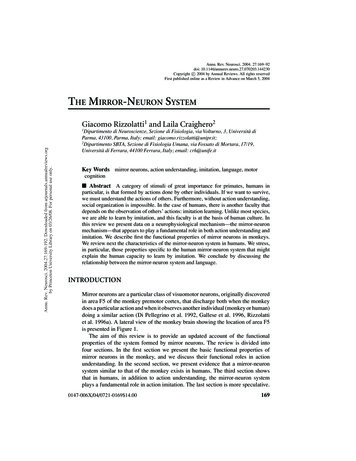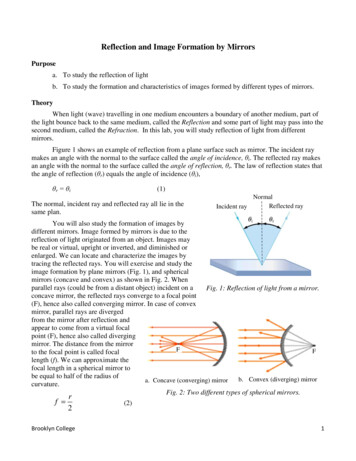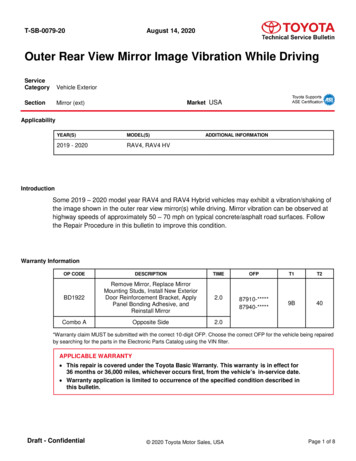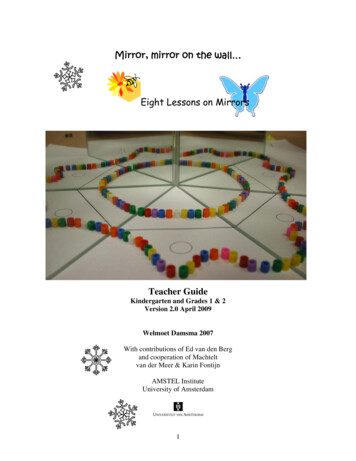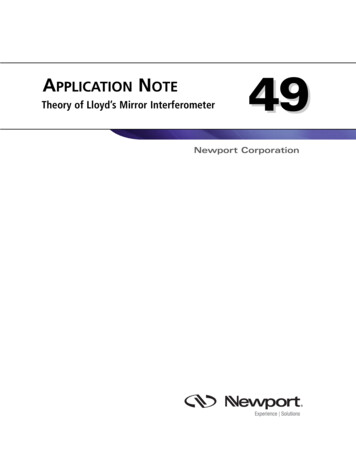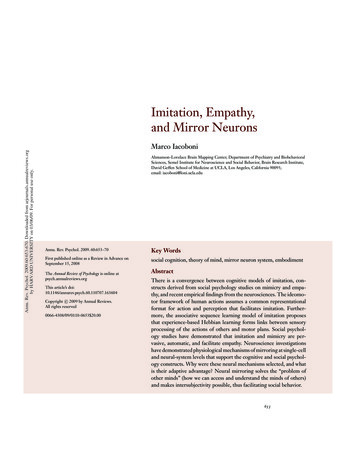
Transcription
ANRV364-PS60-25ARIANNUALREVIEWS24 November 200818:59FurtherAnnu. Rev. Psychol. 2009.60:653-670. Downloaded from arjournals.annualreviews.orgby HARVARD UNIVERSITY on 03/06/09. For personal use only.Click here for quick links toAnnual Reviews content online,including: Other articles in this volume Top cited articles Top downloaded articles Our comprehensive searchImitation, Empathy,and Mirror NeuronsMarco IacoboniAhmanson-Lovelace Brain Mapping Center, Department of Psychiatry and BiobehavioralSciences, Semel Institute for Neuroscience and Social Behavior, Brain Research Institute,David Geffen School of Medicine at UCLA, Los Angeles, California 90095;email: iacoboni@loni.ucla.eduAnnu. Rev. Psychol. 2009. 60:653–70Key WordsFirst published online as a Review in Advance onSeptember 15, 2008social cognition, theory of mind, mirror neuron system, embodimentThe Annual Review of Psychology is online atpsych.annualreviews.orgThis article’s doi:10.1146/annurev.psych.60.110707.163604c 2009 by Annual Reviews.Copyright All rights reserved0066-4308/09/0110-0653 20.00AbstractThere is a convergence between cognitive models of imitation, constructs derived from social psychology studies on mimicry and empathy, and recent empirical findings from the neurosciences. The ideomotor framework of human actions assumes a common representationalformat for action and perception that facilitates imitation. Furthermore, the associative sequence learning model of imitation proposesthat experience-based Hebbian learning forms links between sensoryprocessing of the actions of others and motor plans. Social psychology studies have demonstrated that imitation and mimicry are pervasive, automatic, and facilitate empathy. Neuroscience investigationshave demonstrated physiological mechanisms of mirroring at single-celland neural-system levels that support the cognitive and social psychology constructs. Why were these neural mechanisms selected, and whatis their adaptive advantage? Neural mirroring solves the “problem ofother minds” (how we can access and understand the minds of others)and makes intersubjectivity possible, thus facilitating social behavior.653
ANRV364-PS60-25ARI24 November 200818:59ContentsAnnu. Rev. Psychol. 2009.60:653-670. Downloaded from arjournals.annualreviews.orgby HARVARD UNIVERSITY on 03/06/09. For personal use only.INTRODUCTION . . . . . . . . . . . . . . . . . .COGNITIVE MECHANISMSOF IMITATION . . . . . . . . . . . . . . . . . .The Ideomotor Frameworkof Imitation . . . . . . . . . . . . . . . . . . . . .Associative Sequence Learning . . . . .IMITATION AND EMPATHYIN SOCIAL BEHAVIOR . . . . . . . . . .Pervasiveness and Automaticityof Human Imitation . . . . . . . . . . . . .NEURAL MECHANISMSOF IMITATION . . . . . . . . . . . . . . . . . .Neural Precursorsin Nonhuman Primates . . . . . . . . .Macaque Mirror Neuronsand Imitation in Monkeys . . . . . . .Human Brain Mechanismsof Mirroring . . . . . . . . . . . . . . . . . . . .Neural Mirroring and PsychologicalTheories of Imitation . . . . . . . . . . .WHY NEURAL MIRRORINGAND IMITATION? . . . . . . . . . . . . . . .Hebbian learning:associative learning isimplemented bysimultaneousactivation of cells thatwould lead toincreased synapticstrength between ng cognitive models of imitation, theideomotor model and the associative sequencelearning model seem to map well onto neurophysiological mechanisms of imitation. Theideomotor model assumes a common representational format for action and perception, whereas the associative sequence learningmodel puts at center stage Hebbian learning asa fundamental mechanism linking sensory representations of the actions of others to motorplans. Furthermore, social psychology studieshave documented the automaticity of imitationand mimicry in humans, a feature that also mapswell onto some recently disclosed neurophysiological bases of imitation.This review discusses cognitive models, social psychology constructs, and neural mechanisms of imitation under the hypothesis thatthese mechanisms were selected because theyoffer the adaptive advantage of enabling the understanding of the feelings and mental states ofothers, a cornerstone of social behavior.COGNITIVE MECHANISMSOF IMITATIONINTRODUCTIONThe Ideomotor Frameworkof ImitationAlthough mimicry is a pervasive phenomenonin the animal kingdom, imitation certainlyachieves its highest form in humans. Pastauthors—for instance, de Montaigne (1575),Adam Smith (1759), Poe (1982), Nietzsche(1881), and Wittgenstein (1980)—have oftenassociated imitation with the ability to empathize and understand other minds. The evolutionary, functional, and neural mechanismslinking imitation to empathy, however, havebeen unclear for many years. Recently, there hasbeen a convergence between cognitive models of imitation, social psychology accounts ofits pervasiveness and its functional links withempathy and liking, and the neuroscience discoveries of neural mechanisms of imitationand empathy. This convergence creates a solidframework in which theory and empirical datareinforce each other.Theories of action can be divided into twomain frameworks. The most dominant framework may be called the sensory-motor framework of action. It assumes that actions are initiated in response to external stimuli. In thisframework, perception and action have independent representational formats. Stimuli mustbe translated into motor responses by stimulusresponse mapping mechanisms. This framework has generated a large literature and elegant experimental paradigms, as for instancethe work on stimulus-response compatibility(Hommel & Prinz 1997, Proctor & Reeve1990). Stimulus-response translational mechanisms, however, do not easily account for thesimilarity between the observed action and theaction performed by the imitator that is required by imitation. Indeed, one of the mainproblems of imitation often discussed in theIacoboni
Annu. Rev. Psychol. 2009.60:653-670. Downloaded from arjournals.annualreviews.orgby HARVARD UNIVERSITY on 03/06/09. For personal use only.ANRV364-PS60-25ARI24 November 200818:59literature inspired by sensory-motor modelsis the so-called correspondence problem (Nehaniv & Dautenhahn 2002). This problemcan be summarized with the question: how isthe sensory input from somebody else’s actiontransformed into a matching motor output bythe imitator?For the ideomotor framework of action, thecorrespondence problem of imitation is not aproblem at all. Indeed, the ideomotor framework assumes a common representational format for perception and action, an assumption that makes translational processes betweenstimuli and responses rather unnecessary. Theroots of the ideomotor framework were established by the work of Hermann Martin Lotze(Prinz 2005) and William James (1890). Thestarting point of actions, for Lotze and James,is not a response to a sensory stimulation, butrather the representation of the goal that theagent intends to achieve. When an intentionis unchallenged by a conflicting one, it activates the representation of the intended goaland the motor plan necessary to achieve it. Thecoactivation of the intended goal and the motor plan required to achieve it—according tothe ideomotor framework—is the result of ourexperience. We have learned the effects of ourown actions, and we expect certain effects whenwe perform certain acts. This previous learningmakes it possible that just thinking about theintended goal automatically activates the representation of the action necessary to obtain it.Thus, when I think about rebooting my computer, I automatically activate the representation of the finger movement necessary to pressthe appropriate key.The ideomotor framework naturally accounts for imitation. According to this framework, when I see somebody else’s actions andtheir consequences, I activate the representations of my own actions that would producethose consequences. Here, consequences areconstrued in a very broad sense. For instance,a simple finger lifting has multiple perceptualconsequences, among them the sight of the finger lifting. Thus, simply watching somebodyelse lifting a finger should activate my own mo-tor plan to lift the same finger. Brass and colleagues tested this hypothesis in elegantly simple experiments (Brass et al. 2000, 2001). Subjects were shown two movements of the indexfinger from the same starting position. In halfof the trials the finger would move upward,and in the other half it would move downward.Subjects were instructed to respond as fast aspossible using their own index finger. Withineach block of trials, subjects were instructed touse always the same motor response, either anupward or a downward movement. Thus, although perceptually subjects were seeing bothupward and downward movements, motoricallythey were only executing one of the two movements. Given that response selection was notrequired, the identity of the stimulus was completely irrelevant for the initiation of the motorresponse. Here, the sensory-motor frameworkwould predict similar reaction times for responses that were identical to the stimulus (e.g.,upward motor response for a stimulus showingan upward finger movement) and for responsesthat were different from the stimulus (e.g., upward motor response for a stimulus showing adownward finger movement). In contrast, theideomotor framework would predict faster reaction times for motor responses identical tothe stimulus compared to motor responses different from the stimulus. The results demonstrated a large chronometric advantage for responses identical to the stimuli, in line with thepredictions of the ideomotor framework (Brasset al. 2000, 2001).The ideomotor framework also predicts thatgoals have higher priority than movements inimitation. Imitation experiments in childrenhave confirmed this prediction. In one of theseexperiments (Bekkering et al. 2000), childrenand experimenters were sitting on the oppositesides of a desk. In half of the trials the experimenter would place her or his left hand on theleft side of the desk (left ipsilateral movement)or on the right side of the desk (left contralateralmovement); in the remaining half of the trialsthe experimenter would place her or his righthand on the right side of the desk (right ipsilateral movement) or on the left side of the deskwww.annualreviews.org Imitation, Empathy, and Mirror Neurons655
ANRV364-PS60-25ARI24 November 2008Annu. Rev. Psychol. 2009.60:653-670. Downloaded from arjournals.annualreviews.orgby HARVARD UNIVERSITY on 03/06/09. For personal use only.Associative sequencelearning: imitation isbased on associative,Hebbian-like learning,creating “verticallinks” between sensoryand motorrepresentations18:59(right contralateral movement). Children wereinstructed to “Do what I do,” and in all cases,they imitated all these movements well. In a separate session, children and experimenters wereagain sitting on the opposite sides of the desk.Now, however, there were two big red dots, oneon the left and one on the right side of the desk.Whenever the experimenter made a movement,either ipsilateral or contralateral with either theleft or the right hand, the hand of the experimenter would end up covering the big red dot.Children were again instructed to “Do what Ido.” In this situation, children imitated well theipsilateral movements but made frequent mistakes when trying to imitate the contralateralmovements. Note that these movements hadbeen imitated well in absence of the big red dot.The presence of the big red dot had changed thegoal of the action to be imitated. Whereas inthe absence of the dot, the action itself was thegoal to be imitated, the presence of the dot hadchanged the goal of the action in covering thedot. Indeed, children made mistakes when imitating contralateral movements because theyused ipsilateral movements to cover the samedot that had been covered by the experimenter.In other words, children would copy the goalbut used a simpler movement to achieve thisgoal (Bekkering et al. 2000).One of the main assumptions of the ideomotor framework is that action and perceptionshare a common representational format. Thisassumption fits well recent neuroscience discoveries, as discussed below. Another important assumption of the ideomotor frameworkis that our perceptual and motor experience isvery important in shaping the functional aspectsof imitation. This assumption is also shared bythe associative sequence learning model (Heyes2005), as described in the next section.Associative Sequence LearningThe associative sequence learning model of imitation proposes that imitative abilities are basedon associations between the sensory and motor representation of actions. These associations would be mostly shaped by experience,656Iacobonialthough a small number of these associationsmay be innate. Several environmental situationsmay favor the establishment of these associations between sensory and motor representation of actions, for instance, visually guidedactions, such as reaching and grasping, duringwhich we can observe our own arm and handreach and grasp for objects surrounding us.Also, mirrors and other reflecting surfaces allow the observation of one’s own facial and bodymovement as if they were performed by somebody else. Furthermore, early in human development, adults tend to imitate the baby (Nadel2002), thus favoring the formation of the associations between sensory and motor representations of actions.The basic assumption of the associativesequence learning model is that imitation isnot based on dedicated functional (and neural)mechanisms. General sensory and motor systems may implement imitative abilities throughmechanisms that are strongly reminiscent ofHebbian learning. One of the corollaries of thisassumption is that imitation should not be confined to specific lineages. Indeed, although primates clearly show varying degrees of imitative abilities, birds (Akins et al. 2002) and dolphins (Herman 2002) also seem able to imitate. Thus, imitative behavior appears to be theproduct of convergent evolution. If this is true,then the hypothesis that imitation is mostlyshaped by experience—as assumed by the associative sequence learning model—is obviouslysupported.The role of experience and the environmentin shaping imitative abilities may also accountfor evidence that at first sight seems at oddswith the basic assumptions of the associativesequence learning model. Many animals sharesimilar basic sensory and motor functional andneural mechanisms. In principle, this shouldlead to similar imitative skills in many animals. Imitation abilities, however, vary substantially between species (Boysen & Himes 1999,Hurley & Chater 2005). Is this evidence a fatal blow to the main assumption of the associative sequence learning model? Probably not.Indeed, different kinds of environments may
Annu. Rev. Psychol. 2009.60:653-670. Downloaded from arjournals.annualreviews.orgby HARVARD UNIVERSITY on 03/06/09. For personal use only.ANRV364-PS60-25ARI24 November 200818:59account for the differences in imitative abilities observed in different species. As discussedabove, some elements that are quite specific tothe human environment should favor the formation of the associations between sensory andmotor representations posited by the associative sequence learning model. In keeping withthese ideas, humans are by far the best imitators(Hurley & Chater 2005).Empirical evidence in well-controlled laboratory experiments seems to support the roleof experience in shaping imitation, as hypothesized by the associative sequence learningmodel. For instance, hand-opening and handclosing gestures are typically facilitated by theobservation of the same movement compared tothe observation of a different movement. However, this facilitation can be abolished by a relatively short period of training during whichsubjects are instructed to open the hand whileobserving hand closing, and to close the handwhile observing hand opening (Heyes et al.2005).In another experiment, the effect of training was measured on the speed of imitationinduced by the observation of human motionversus robotic motion. A typical finding is thathumans imitate more quickly the movements ofanother human compared to the movements ofa robot. This effect, however, may be simply because humans tend to interact more with otherhumans than with robots. Indeed, subjects whowere trained to execute hand movement in response to a robotic movement demonstrated nodifference in speed of imitation while observing human and robotic movements (Press et al.2007).Although the associative sequence learningmodel and the ideomotor framework of imitation share the main idea that experience is extremely important for imitation, they also seemto differ on an important point. The associativesequence learning model assumes that separatesensory and motor representations are linked byexperience. In contrast, the ideomotor framework assumes that sensory and motor functional mechanisms share a common represen-tational format. In psychological terms, thesedifferences are not negligible. The translationof these different concepts into neural activity,however, as discussed below, may not differ dramatically (Glimcher 2005). Indeed, the mainassumptions of both the associative sequencelearning model and the ideomotor frameworkof imitation fit well with recent neurosciencefindings on imitation.IMITATION AND EMPATHYIN SOCIAL BEHAVIORPervasiveness and Automaticityof Human ImitationHumans seem to have a strong tendency to aligntheir behavior with their fellows during socialinteractions (Lieberman 2007). Some of theseforms of imitation and mimicry are not onlypervasive and automatic, but also operate ona quite complex level. Ap Dijksterius (2005)—following LeDoux’s terminology on processingof fearful stimuli (LeDoux 1996)—suggests thatthere are two roads to human imitation. A lowroad leads to imitation in a direct fashion, suchthat the perceiver acts the gestures, postures, facial expressions, and speech perceived in otherpeople. A high road leads to complex and rathersubtle forms of imitation, as shown by a number of experiments with priming manipulations that lead to stereotype activation or traitactivation.An example of stereotype activation onmotor behavior is provided by the following experiment. Participants performed ascrambled-sentence language task. Some subjects were exposed to words such as Florida,bingo, gray; that is, words typically associatedwith the elderly. Some other subjects were not.After the experiment, participants left the laboratory and walked back to the elevator to leavethe building. An experimenter timed this walkback to the elevator. Subjects who had beenprimed with the elderly stereotype were reliably slower than subjects who had not beenprimed (Bargh et al. 1996). The primed subjectswww.annualreviews.org Imitation, Empathy, and Mirror Neurons657
ARI24 November 200818:59imitated—obviously in an unconscious way—the slowness of old people.The high road to imitation is also at workin memory and general knowledge tasks. Inone experiment, subjects sat in front of a deskfull of objects. The stereotype of the elderlywas primed again in some subjects by askingthem questions on elderly people. Other subjects, in contrast, were asked questions aboutcollege students. Subsequently, subjects weretransferred to another room and were asked toremember the objects that were on the desk infront of them. The subjects primed with theelderly stereotype remembered far fewer objects than did the other participants (Dijksterhuis et al. 2000).In a series of experiments, participants wereeither asked to think about college professors(a group of people typically associated with intelligence) and to write down everything thatcame to mind about college professors, or theywere asked to think about soccer hooligans(a group of people typically not associated withintelligence) and to write down everything thatcame to mind about soccer hooligans. In alater task involving general knowledge questions, a task that was ostensibly unrelated tothe first one, the participants who were askedto think about college professors outperformedthe participants who were asked to think aboutsoccer hooligans. Indeed, the participants whowere asked to think about college professorseven outperformed participants who were notasked anything at all, and the participants whowere asked to think about soccer hooliganswere outperformed by participants who werenot asked anything at all (Dijksterhuis & vanKnippenberg 1998).Many more studies support the concept thatthe high road to imitation is pervasive and automatic (Dijksterhuis 2005). The question is whypervasiveness and automaticity have been selected as distinctive properties of the high roadto imitation. One possibility is that imitation facilitates social interactions, increases connectedness and liking, gets people closer to eachother, and fosters mutual care. If this accountAnnu. Rev. Psychol. 2009.60:653-670. Downloaded from arjournals.annualreviews.orgby HARVARD UNIVERSITY on 03/06/09. For personal use only.ANRV364-PS60-25658Iacoboniis correct, it should follow that good imitators should also be good at recognizing emotions in other people, which in turn may leadto greater empathy. Thus, this account wouldpredict a correlation between the tendency toimitate others and the ability to empathize withthem. This hypothesis was tested in a series ofexperiments (Chartrand & Bargh 1999). In thefirst experiment, subjects were asked to choosepictures in a set of photographs. The coverstory was that the researchers needed someof these pictures for a psychological test andwanted to know from the subjects which pictures they considered more stimulating. Whilesubjects were choosing the pictures, a confederate was sitting in the same room with the realsubject. The confederate pretended to be another subject who was also choosing good stimulating pictures. During the experimental sessions, some confederates deliberately rubbedtheir nose while the others shook their foot.Subjects were videotaped and their motor behavior was measured. It was found that the realsubjects unintentionally mimicked the motorbehavior of the confederate with whom theywere sharing the room. Subjects who sharedthe room with confederates who rubbed theirnose, rubbed their nose more than did subjectswho shared the room with confederates whoshook their foot. Furthermore, subjects whoshared the room with confederates who shooktheir foot, shook their foot more than did subjects who shared the room with confederateswho rubbed their nose. These results are in linewith the idea that imitation is automatic andprovide the necessary prelude to the followingexperiments.The second experiment tested the hypothesis that one of the functions of this automatictendency to imitate is to increase liking betweenindividuals. Participants were again asked tochoose pictures, and confederates were againsitting with them, pretending to be participantsof the study. In this second experiment, thecover task required participants and confederates to take turns in describing what they sawin various photos. At the end of the interaction
Annu. Rev. Psychol. 2009.60:653-670. Downloaded from arjournals.annualreviews.orgby HARVARD UNIVERSITY on 03/06/09. For personal use only.ANRV364-PS60-25ARI24 November 200818:59between participants and confederates, the participants were also asked to complete a questionnaire to report how much they liked theother participant (that is, the confederate) andhow smoothly they thought the interaction hadgone. In this second experiment, the confederates either imitated the spontaneous postures,movements, and mannerisms of the subjects orkept a neutral posture. The participants whowere mimicked by confederates during the interaction liked the confederates much morethan did the participants who were not imitated. Furthermore, mimicked subjects ratedthe smoothness of the interaction higher thandid the participants who were not imitated.This experiment demonstrated that imitationand liking tend to go together. When someone is imitating us, we tend to like him or hermore.A third experiment tested the hypothesisthat the more people tend to imitate others, themore they are concerned with the feelings ofother people. The setting of this third experiment was identical to the first experiment. Thenovel aspect of this last experiment was that theparticipants responded to a questionnaire thatmeasured their empathic tendencies. The experiment found a strong correlation betweenthe tendency to empathize and the amount ofimitative behavior displayed by the participants.The more a subject imitated the confederate,the more that subject was an empathic individual (Chartrand & Bargh 1999). This result suggests that through imitation and mimicry, weare able to feel what other people feel. By beingable to feel what other people feel, we are alsoable to respond compassionately to other people’s emotional states (Eisenberg 2000, Tangneyet al. 2007).Many other empirical results are consistent with these ideas (Braten 2007, Niedenthalet al. 2005). What are the neural correlates ofthese complex forms of human behavior? A recent discovery in the monkey premotor cortexhas sparked a whole series of new studies, inmonkeys and humans, that are relevant to thisquestion.NEURAL MECHANISMSOF IMITATIONNeural Precursorsin Nonhuman PrimatesThe premotor cortex of the macaque brain,a cortical region important for the planning, preparation, and selection of movementsand coordinated actions, is not homogeneous(Matelli et al. 1985). It is composed of severalcito-architectonic fields with different physiological properties. In the lateral wall of themacaque brain, the ventral sector of the premotor cortex is composed of two main fields, areaF4 and area F5 (Matelli et al. 1985). Area F5 hasphysiological properties relevant to the neuralcontrol of mouth and hand movements, especially grasping (Rizzolatti et al. 1988). Withinarea F5, there are neurons that discharge notonly when the monkey performs goal-orientedactions such as grasping an object, holding it,manipulating it, and bringing it to the mouth,but also when the monkey, completely still, simply observes somebody else performing theseactions. Because of these properties, which almost suggest that the monkey is observing itsown actions reflected by a mirror, these cellswere called mirror neurons (di Pellegrino et al.1992, Gallese et al. 1996).The properties of mirror neurons call tomind the concepts of the ideomotor framework of actions, according to which perceptionand action share common representational formats. Indeed, mirror neurons embody the overlap between perception and action predictedby the ideomotor framework by dischargingboth during action execution and during actionobservation.The initial hypothesis about the functionalrole of mirror neurons focused on action recognition. By firing during actions of the self andof other individuals, mirror neurons may provide a remarkably simple neural mechanism forrecognizing the actions of others. Early observations on firing-rate changes in mirror neurons demonstrated that these cells do not fire atthe sight of a pantomime (Rizzolatti et al. 1996,www.annualreviews.org Imitation, Empathy, and Mirror NeuronsPremotor cortex:anterior sector of theagranular frontalcortex containingneurons that arerelevant to theplanning, preparation,and selection of actionsMirror neurons:neurons with motorproperties in premotorand posterior parietalcortex that fire notonly during actionexecution, but alsowhile observingsomebody elseperforming the sameor a similar action659
ANRV364-PS60-25ARI24 November 2008Annu. Rev. Psychol. 2009.60:653-670. Downloaded from arjournals.annualreviews.orgby HARVARD UNIVERSITY on 03/06/09. For personal use only.Strictly congruentmirror neurons:mirror neurons thatfire during theobservation of exactlythe same action theycode motoricallyBroadly congruentmirror neurons:mirror neurons thatfire during theobservation of anaction achieving thesame goal or logicallyrelated to the actionthey code motorically66018:59Rizzolatti & Arbib 1998). For instance, the pantomime of whole-hand grasp (when the wholehand is used to grasp a relatively large object,as an orange) does not trigger the discharge ofa mirror neuron that fires during execution andobservation of whole-hand grasps. This makessense because monkeys typically do not pantomime. These early findings suggested that theproperties of this neural system were remarkable but relatively simple, some sort of “monkeysee, monkey do” neural mechanisms. However,many other findings contradict this view andrather suggest that mirror neurons form a sophisticated, nuanced system for shared codingof motor and perceptual aspects of actions ofself and others (Rizzolatti & Craighero 2004).For instance, although the term “mirror”implies a strong similarity between the executedand the observed actions, only one third ofmirror neurons—the so-called strictly congruent mirror neurons—fire for the same executedand observed action. The remaining two-thirdsof mirror neurons—the so-called broadly congruent mirror neurons—fire for executed andobserved actions that are not the same but either achieve the same goal or are logically related (di Pellegrino et al. 1992, Gallese et al.1996, Rizzolatti & Craighero 2004), thus forming some sort of sequence of acts, as for instanceobserved placing food on the table and executedgrasping food and bringing it to the mouth.The properties of broadly congruent mirrorneurons suggest that these cells provide a flexible coding of actions of self and others. Thisflexibility is an important property for successful social interactions because even though imitation is a pervasive phenomenon in humans,people do not imitate each other all the timebut rather often perform coordinated, cooperative, complementa
www.annualreviews.org Imitation, Empathy, and Mirror Neurons 655 Annu. Rev. Psychol. 2009.60:653-670. Downloaded from arjournals.annualreviews.org by HARVARD UNIVERSITY on 03/06/09. For personal use only. ANRV364-PS60-25 ARI 24 November 2008 18:59 Associative sequence learning: imitation is
